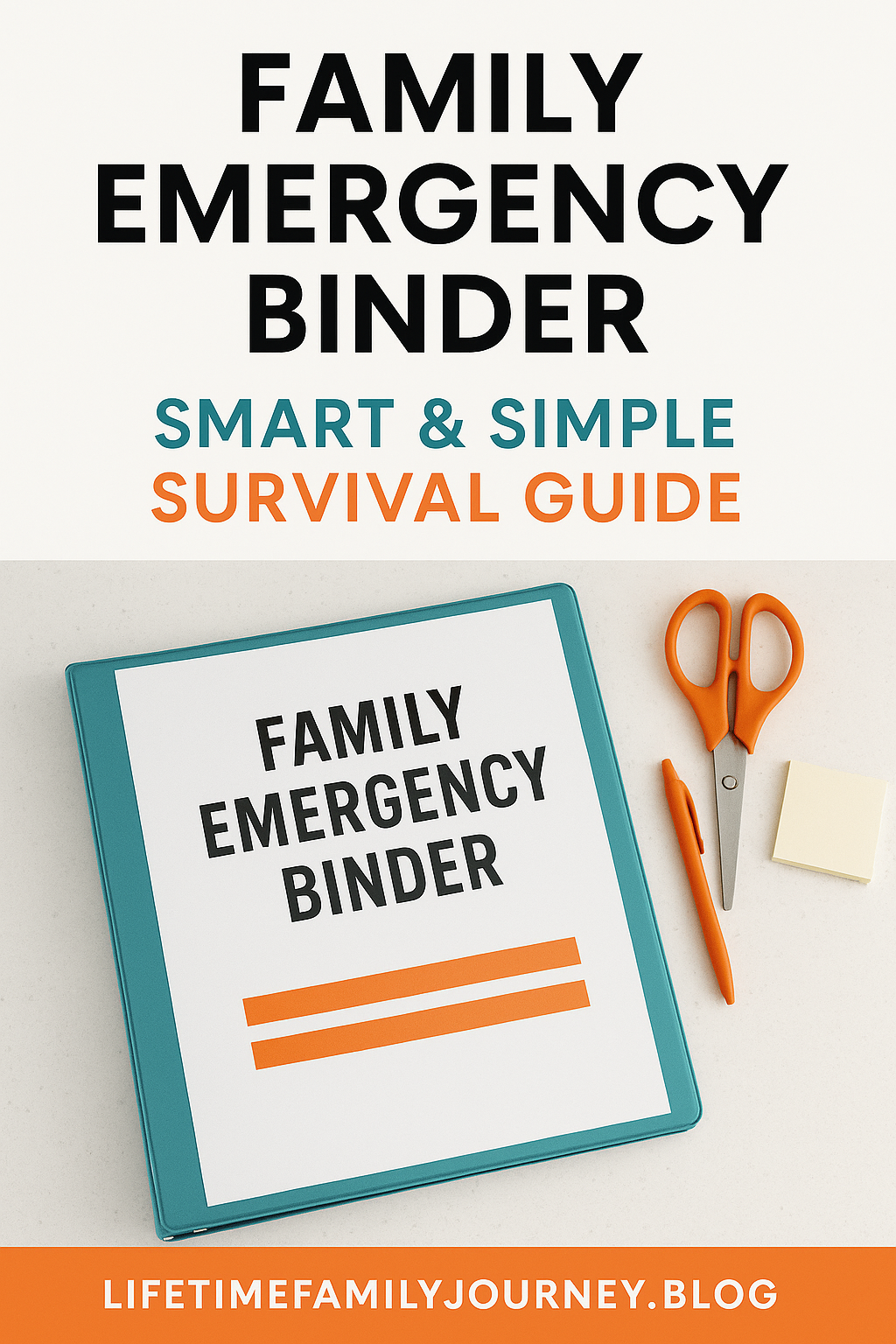Family Emergency Binder: Smart & Simple Survival Guide
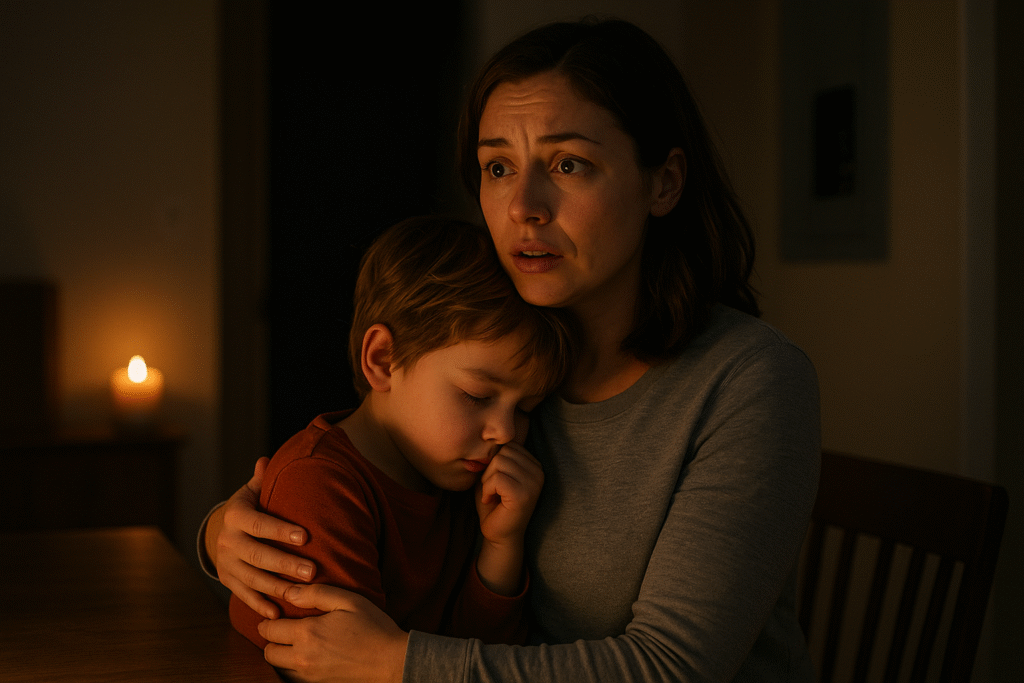
The power’s out in the middle of the night, and my six-year-old is convinced the house is under alien attack. Meanwhile, I’m stumbling through the dark trying to remember which breaker controls what, where I put the flashlight batteries, and—oh yeah—what’s the number for the electric company again?
Spoiler alert: I found none of those things that night. But I did find something important—the realization that our family needed a serious upgrade in the preparedness department. Not the “build a bunker” kind of preparedness. Just the kind where you can find what you need when things go sideways.
That’s exactly why we built our family emergency binder. And before you roll your eyes thinking this is some elaborate Pinterest project involving laminating machines and color-coded perfection, let me stop you right there. This is practical stuff. The kind of system that actually works when your teenager needs their insurance card at urgent care, or when the neighbor kid’s mom needs your contact info because little Brayden decided to test gravity off the swingset (again).
If your important papers are scattered across three junk drawers, stuffed in your glove compartment, and saved on a laptop that may or may not still turn on, this guide’s for you. Let’s talk about building a family emergency binder that you’ll actually use—no thesis-writing required. ✅
What Exactly Is a Family Emergency Binder? 📋
A family emergency binder is basically your household’s control center condensed into one organized place. Think of it as the instruction manual for your family that nobody wrote until now.
It’s a physical binder (yes, old school) that holds copies—not originals, we’re not insane—of all the vital information someone would need if you weren’t available to answer questions. Medical histories. Emergency contacts. Insurance policies. School info. Utility account numbers. The Wi-Fi password that you definitely don’t remember off the top of your head.
Here’s what it’s not: it’s not a 200-page scrapbook project. It’s not something that needs to be Instagram-worthy. And it’s definitely not something you’ll build once and then never touch again. (Though let’s be honest, we all have good intentions about that last part.)
The goal is simple—when chaos hits, you grab one thing and you’re covered. No hunting. No guessing. No panicking because you can’t remember if you paid that bill or which kid has the penicillin allergy.
Real Talk: If it looks like a college thesis, nobody’s opening it in a blackout. Keep it simple, keep it functional, and save the decorative tabs for your bullet journal. 💡
In our house, the binder lives on a specific shelf in the kitchen. Everyone over age 10 knows where it is. That’s the level of complexity we’re aiming for here—not complicated, just organized.
Why Every Family Actually Needs One (Yes, Even Yours) 🏠

I get it. You’re thinking, “We’ve made it this far without one.” Same, friend. Same. Until the day we didn’t.
For the Big, Scary Emergencies 🚨
Let’s start with the obvious stuff—natural disasters, medical emergencies, evacuations. The times when adrenaline is pumping and clear thinking is not your strong suit.
When our oldest, Natalie, had a severe allergic reaction at college (turns out she’s allergic to something in cheap ramen—who knew?), the ER needed her complete medical history. Fast. My wife was two hours away teaching, I was at work, and Natalie was not in a state to remember every childhood vaccine she’d ever had. Thank goodness for our emergency binder backup on her phone. Crisis managed.
The Ready.Gov Family Communication Plan talks about having this information ready to go, and they’re not wrong. When your brain is in panic mode, you need your preparation to kick in.
But here’s the thing—most of us don’t face tornados or evacuations regularly. (And if you do, you’re probably already way ahead on this.) So let me give you the real reason you need this.
For the Everyday Chaos 🎭
Your family emergency binder isn’t just for emergencies. It’s for:
→ The babysitter who needs to know where the thermometer is and which kid can’t have ibuprofen
→ Your spouse who swears they don’t know the kids’ Social Security numbers (even though they’re on the tax return)
→ The school office calling for updated medical forms during dinner prep
→ Finding proof of residence for the 47th time this year
→ Your teenager who needs to call the insurance company about that fender bender
See? Not dramatic. Just useful. The kind of useful that saves you 20 minutes of frantic searching on a random Tuesday. And if you’re looking for ways to create more peace in your household, getting organized is step one.
Truth Bomb: Emergencies don’t RSVP. But your binder should always be ready. 🎯
We’ve pulled our binder out more times for mundane life chaos than actual disasters. Last month alone: substitute teacher paperwork for homeschool co-op, vet records for boarding the dog, and when the internet went down and I needed to call the provider (because apparently I never saved that number in my phone).
Your life is unpredictable. Your binder doesn’t have to be.
When Families Actually Use Their Emergency Binder 📊
Here’s a breakdown of how often we’ve reached for our binder over the past year, and why:
Emergency Binder Usage - 12 Month Tracking
━━━━━━━━━━━━━━━━━━━━━━━━━━━━━━━━━━━━━━━━━━━
Medical Situations ████████████████░░░░ 42% (21 times)
School/Activity Forms ██████████░░░░░░░░░░ 28% (14 times)
Insurance Questions ████████░░░░░░░░░░░░ 18% (9 times)
Utility Issues ████░░░░░░░░░░░░░░░░ 8% (4 times)
True Emergencies ██░░░░░░░░░░░░░░░░░░ 4% (2 times)
Total Uses: 50 times in one year
That's nearly once per week! 📈
Notice anything? Real emergencies are the smallest category. This thing earns its keep in everyday life.
What Goes Inside Your Family Emergency Binder 📑
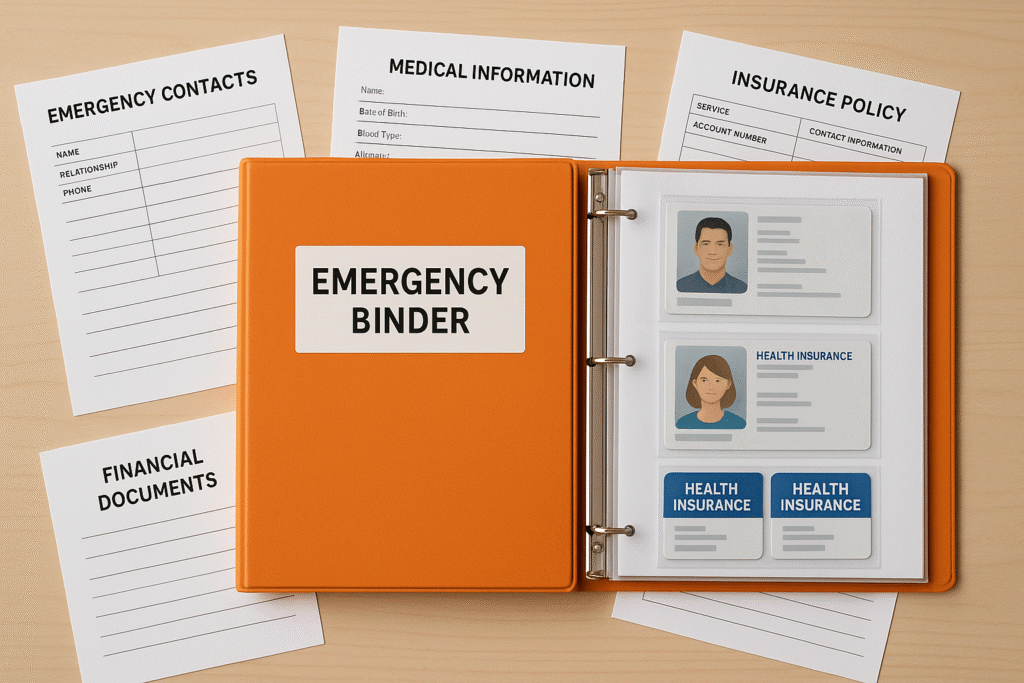
This is where people either go minimalist (three papers and hope) or maximalist (entire filing cabinet crammed into sheet protectors). Neither is the move. Let’s find the middle ground.
Personal & Household Information 👨👩👧👦
Start with the basics—the information that identifies your family and helps someone reach you or help you:
• Emergency contact list (family, neighbors, friends, pediatrician, vet)
• Copies of driver’s licenses and IDs for all family members
• Birth certificates (copies, not originals)
• School information (contacts, schedules, important dates)
• Pet records (microchip numbers, vet info, medications)
• Family roster with ages, photos, and any special needs
Pro Tip: Laminate a single-page contact sheet with your top 10 emergency numbers. Stick one in the binder, one in each car, and one in your go-bag. When things go sideways, you don’t want to be flipping through pages.
In our house, this section gets updated the most. Kids change schools, phone numbers change, the pediatrician retires. I check it during back-to-school season and again after New Year’s. Takes 10 minutes. Totally worth it. (And speaking of getting organized for the school year, our back-to-school survival guide has more tips on managing the chaos.)
Health & Medical Records 🏥
This section might literally save a life someday, so don’t skip it:
• Current medications (names, dosages, prescribing doctors)
• Allergies (food, medications, environmental)
• Immunization records
• Insurance cards (medical, dental, vision—front and back copies)
• Medical history summaries for each family member
• Medical consent forms (for caregivers, schools, camps)
• Doctors’ contact information (primary care, specialists, dentists)
The Red Cross preparedness resources emphasize having medical information accessible, and they’re spot-on. If you end up in an ER or urgent care, nobody wants to play medical history trivia.
Full disclosure: keeping medication dosages current is my Achilles heel. Kids grow. Prescriptions change. Every six months, I mean to update this section. Every eight months, I actually do it. Progress over perfection, right? 😅
Financial & Legal Documents 💰
This section isn’t about storing your actual will or original insurance policies. It’s about having enough information to contact the right people and prove you exist:
• Insurance policy information (home, auto, life—policy numbers and contact info)
• Bank account information (institution names, account types, phone numbers—NO PASSWORDS)
• Mortgage or rent documents (contact info, payment schedules)
• Copy of will/power of attorney locations (note where originals are stored)
• Credit card contact numbers (for fraud reporting)
• Safe deposit box information (location, access instructions)
Here’s what I don’t include: actual passwords, PIN numbers, or account access information. Those go in a separate, secure location (password manager, safe, or vault). The binder gets you to the front door; secure systems get you inside.
When a buddy of mine passed away unexpectedly a few years back, his wife spent weeks trying to figure out which accounts existed and how to contact them. Don’t do that to your family. A simple list of “here’s what we have and here’s who to call” is a gift.
Household Systems & Utilities 🔧
This is the “keeping the house running” section—the stuff that seems obvious until the WiFi dies or a pipe bursts:
• Utility account information (electric, gas, water, internet, trash)
• Home system guides (circuit breaker map, water shut-off location, HVAC basics)
• Appliance manuals (or where to find them)
• Home warranty information
• Repair/service providers (plumber, electrician, HVAC, pest control)
• WiFi network names and passwords
• Babysitter/pet sitter instructions
Because nobody wants to play “guess which breaker controls the kitchen” when the lights go out at dinner time. (Spoiler: in our house, it’s #14. Took three blackouts to figure that out.) For more essential household system tips, check out our guide on DIY household fixes.
Dad Wisdom: Your binder shouldn’t fail when the WiFi does. Keep the important stuff analog. 📶❌
I drew an actual map of our breaker box and stuck it in a sheet protector. Looks amateur? Absolutely. Has it saved me from standing in the dark like an idiot? Also absolutely. (If you need more home safety strategies, I’ve got a whole guide on that too.)
Essential Binder Sections Ranked by Importance ⭐
Based on three years of actual use, here’s what matters most:
CRITICAL SECTIONS (Use weekly)
┏━━━━━━━━━━━━━━━━━━━━━━━━━━━━━━━━━━━━━━━━━┓
┃ 🏥 Medical & Health Info ⭐⭐⭐⭐⭐ ┃
┃ 📞 Emergency Contacts ⭐⭐⭐⭐⭐ ┃
┃ 🏫 School Information ⭐⭐⭐⭐☆ ┃
┗━━━━━━━━━━━━━━━━━━━━━━━━━━━━━━━━━━━━━━━━━┛
IMPORTANT (Use monthly)
┏━━━━━━━━━━━━━━━━━━━━━━━━━━━━━━━━━━━━━━━━━┓
┃ 💰 Insurance Information ⭐⭐⭐⭐☆ ┃
┃ 🔧 Household Systems ⭐⭐⭐☆☆ ┃
┗━━━━━━━━━━━━━━━━━━━━━━━━━━━━━━━━━━━━━━━━━┛
USEFUL (Use quarterly)
┏━━━━━━━━━━━━━━━━━━━━━━━━━━━━━━━━━━━━━━━━━┓
┃ 🏠 Financial & Legal ⭐⭐⭐☆☆ ┃
┃ 🐕 Pet Records ⭐⭐☆☆☆ ┃
┗━━━━━━━━━━━━━━━━━━━━━━━━━━━━━━━━━━━━━━━━━┛
If you’re starting simple, build the top three first. Everything else can wait.
How to Actually Build Your Emergency Binder (Step by Step) 🛠️
Alright, let’s get tactical. You need supplies, a plan, and about an hour of uninterrupted time (which in a house with six kids means waiting until approximately never, but we make it work).
Step 1: Get Your Supplies 🎒
You need: → A 2-inch or 3-inch three-ring binder (go waterproof if possible—I like the ones with the clear front pocket)
→ Sheet protectors (buy the bulk pack, you’ll use them all)
→ Divider tabs with labels (5-8 sections is plenty)
→ A pen that actually works (harder than it sounds)
→ A scanner or phone with a decent camera
Don’t overthink the binder itself. I spent exactly $15 on supplies. This isn’t the place to get fancy. Save the aesthetics for your Instagram stories.
Step 2: Create Your Sections 📂
Use those divider tabs to create clear categories. Mine look like this:
1️⃣ Emergency Contacts
2️⃣ Personal Info & IDs
3️⃣ Medical & Health
4️⃣ Financial & Legal
5️⃣ Household & Utilities
6️⃣ School & Activities
7️⃣ Pet Information
Your sections might look different depending on your family’s needs. Maybe you need one for elderly parent care. Maybe you’ve got a kid with significant medical needs who deserves their own section. Customize it.
Step 3: Gather and Copy Documents 📄
This is the time-consuming part. Round up everything from that junk drawer, your filing cabinet, your email inbox, and wherever else important papers hide.
Make copies, not originals. Scan them if you can—digital backups are your friend. (More on that in a minute.)
Print out templates for the stuff you don’t have yet. Ready.gov has free downloadable emergency planning sheets. Use them. No need to reinvent the wheel here.
Step 4: Fill It In ✍️
Put each document or page into a sheet protector, then file it under the appropriate tab. Write on the sheet protector with a dry-erase marker if you need to add notes or dates.
This is also when you’ll realize how many random passwords and account numbers you think you remember but definitely don’t. It’s humbling. Embrace it. Look them up now so you don’t have to later.
Step 5: Set a Review Schedule 📅
Here’s the trick to making this system work long-term: tie updates to something you already do.
For us, it’s daylight saving time. Twice a year, when we’re already changing clocks and smoke detector batteries, we also check the binder. Are the emergency contacts still current? Did someone switch doctors? Did insurance change?
Ten minutes twice a year keeps this thing functional.
Life Hack: Tie binder updates to daylight saving time—change the clocks, update the binder, check the smoke detectors. One reminder, three wins. ⏰
Step 6: Store It Accessibly 🏠
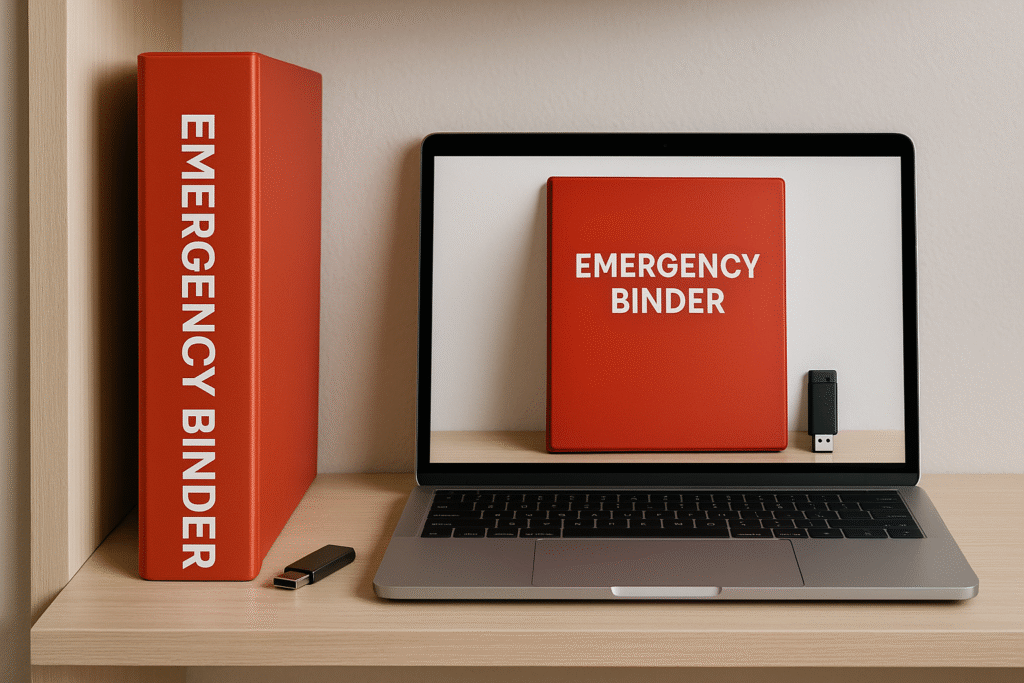
Your family emergency binder needs to live somewhere that’s easy to grab but not in the way. For us, it’s a kitchen shelf at adult eye level. Not hidden in a closet. Not buried under craft supplies. Right there.
Tell everyone in the house where it is. Especially teens and your spouse. A binder nobody can find is a binder that doesn’t exist.
Building Timeline: Week-by-Week Breakdown 📅
Don’t try to do everything at once. Here’s a realistic timeline:
┌────────────────────────────────────────────┐
│ WEEK 1: Setup & Core Info [▓▓▓▓░] │
│ • Buy supplies │
│ • Create sections │
│ • Add emergency contacts │
│ • Scan ID copies │
│ Time needed: 1-2 hours │
└────────────────────────────────────────────┘
┌────────────────────────────────────────────┐
│ WEEK 2: Medical Information [▓▓▓▓░] │
│ • Gather medication lists │
│ • Copy insurance cards │
│ • Write allergy summaries │
│ • Medical consent forms │
│ Time needed: 1.5 hours │
└────────────────────────────────────────────┘
┌────────────────────────────────────────────┐
│ WEEK 3: Financial & Household [▓▓▓░░] │
│ • List bank/insurance contacts │
│ • Note utility account numbers │
│ • Map circuit breakers │
│ Time needed: 1 hour │
└────────────────────────────────────────────┘
┌────────────────────────────────────────────┐
│ WEEK 4: Final Touches & Training [▓▓░░░] │
│ • Add remaining documents │
│ • Create digital backup │
│ • Show family where it lives │
│ Time needed: 45 minutes │
└────────────────────────────────────────────┘
Total Time Investment: 4-5 hours spread over a month
See? Totally manageable. No marathon sessions required.
Digital vs Physical: Which Actually Works? 💻📖
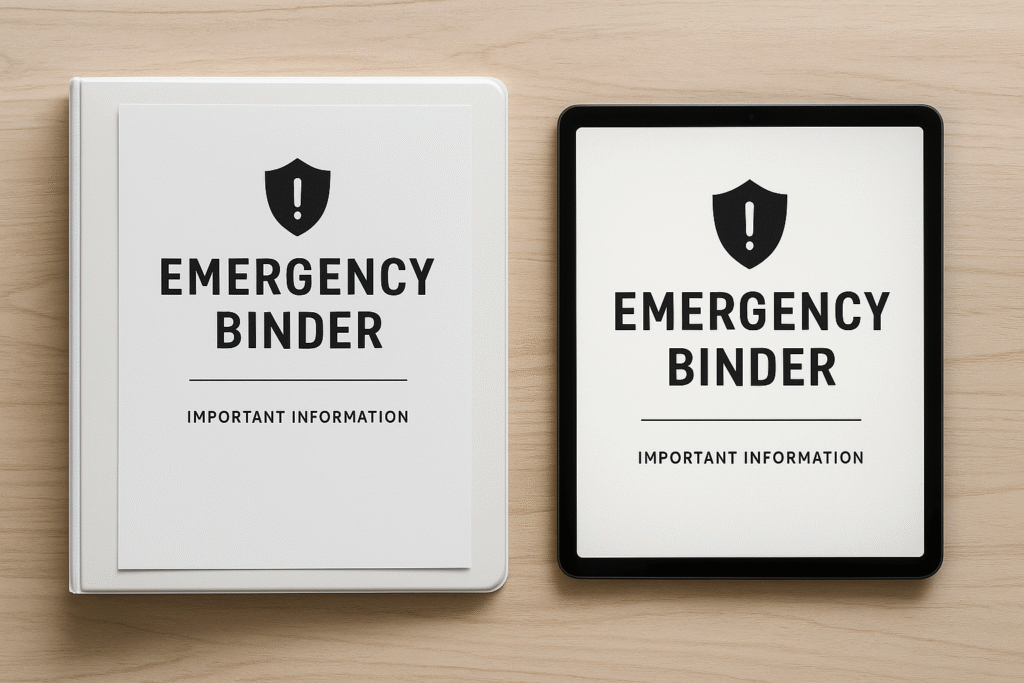
Let’s address the elephant in the room—do you really need a physical binder in 2025? Can’t you just keep everything in Google Drive or on your phone?
Short answer: yes and no.
Physical Binder Pros ✅
→ Works when the power’s out
→ No password needed in a crisis
→ Accessible to anyone who needs it (babysitters, grandparents, EMTs)
→ Harder to accidentally delete
→ Can be grabbed in an evacuation
Digital Backup Pros ✅
→ Easy to update from anywhere
→ Portable (USB drive, cloud storage, phone)
→ Can be shared securely with family members remotely
→ Takes up zero physical space
→ Simple to duplicate and store offsite
The Best Solution? Both. 🤝
I know, I know. That sounds like more work. But hear me out—they serve different purposes.
The physical binder lives at home and serves as your main hub. It’s what you grab during a house fire. It’s what the babysitter flips through when your kid spikes a fever. It’s what your spouse uses when you’re out of town and the insurance company calls.
The digital backup lives in the cloud (we use a secure folder in Google Drive with restricted access) and on an encrypted USB drive in our safe. It’s what you access when you’re away from home. It’s what you can share with Natalie at college or with my parents who might need our information.
I update the digital version more frequently because it’s easier—snap a photo, upload, done. Then twice a year, I print updated pages for the physical binder.
Reality Check: Your binder shouldn’t fail when the WiFi does. Have both. Sleep better. 😴
Could you go fully digital? Sure, if you’re confident you’ll always have power and device access. But I’ve seen too many phones die, clouds get glitchy, and passwords get forgotten to trust only digital. Call me old-fashioned. (My 12 years in the Air Force taught me to plan for when tech fails, and it always does eventually.)
Storage Method Comparison Chart 📊
Here’s how different storage approaches stack up:
═══════════════════════════════════════════════════════════════
METHOD │ ACCESS │ DURABILITY │ COST │ SHAREABILITY
════════════════╪═════════╪════════════╪══════╪══════════════
Physical Binder │ ★★★★★ │ ★★★★☆ │ $15 │ ★★☆☆☆
────────────────┼─────────┼────────────┼──────┼──────────────
Cloud Storage │ ★★★★☆ │ ★★★★★ │ Free │ ★★★★★
────────────────┼─────────┼────────────┼──────┼──────────────
USB Drive │ ★★★☆☆ │ ★★★☆☆ │ $10 │ ★★★☆☆
────────────────┼─────────┼────────────┼──────┼──────────────
Password Mgr │ ★★★★☆ │ ★★★★★ │ $36/yr│ ★★★★☆
────────────────┼─────────┼────────────┼──────┼──────────────
File Cabinet │ ★★☆☆☆ │ ★★★★☆ │ $50 │ ★☆☆☆☆
═══════════════════════════════════════════════════════════════
WINNER: Physical Binder + Cloud Backup (Hybrid Approach) 🏆
The hybrid approach gives you the best of both worlds without breaking the bank.
Teaching Kids About the Emergency Binder 👧👦
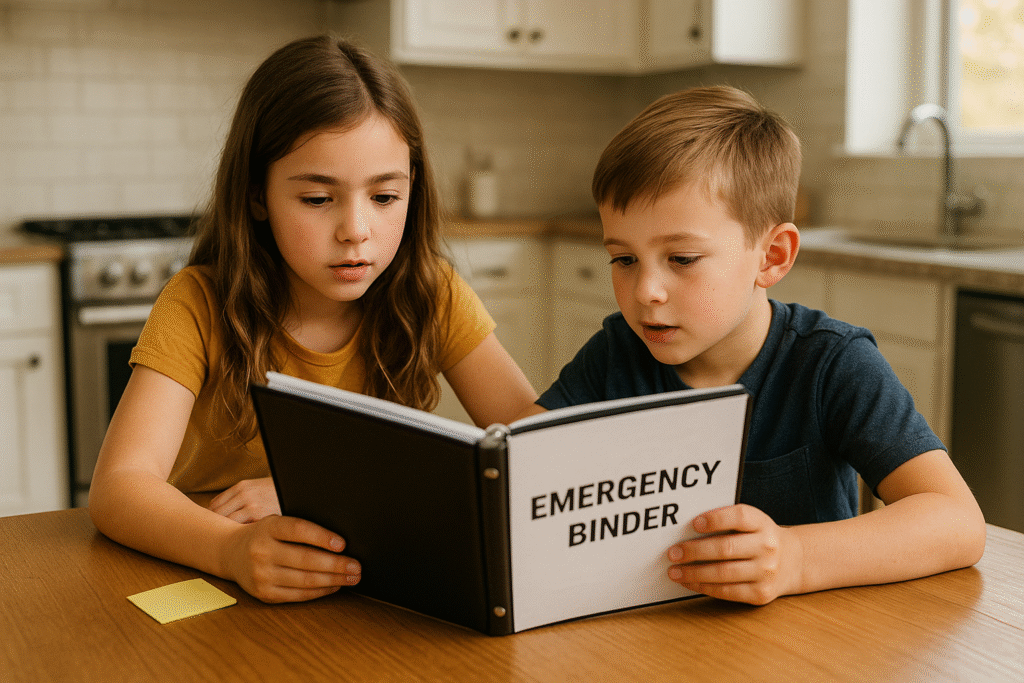
Here’s a fun parenting moment: sitting your kids down to talk about where the important stuff lives and why it matters. Sounds grim, right? It doesn’t have to be.
We introduced the concept when Kaelyn was about 10. Started simple: “Hey, if something happens and you need to call someone, this is where all the phone numbers are.” No drama. No fear-mongering. Just practical information.
For Younger Kids (Ages 5-10) 🧒
→ Show them where the binder lives
→ Explain it’s for “when we need important information”
→ Practice finding Mom and Dad’s phone numbers
→ Make it feel empowering, not scary
Brayden knows the binder is “the grown-up book with the important stuff.” That’s enough for now. When he’s older, we’ll teach him how to actually use it.
For Tweens and Teens (Ages 11+) 🧑
→ Walk them through each section
→ Teach them how to read an insurance card
→ Show them where medical info lives
→ Practice scenarios: “What if I had a medical emergency and you needed to give the ER my medication list?”
→ Update their own information together
Nothing says “adulting practice” like handing your 15-year-old the insurance policy and watching them try to figure out what “deductible” means. (It’s a growth opportunity. And mildly hilarious.)
Why This Matters 🎯
Building confidence in your kids about handling real-life situations is a gift. Melody, our 15-year-old, knew exactly where to find our emergency contact list when our dog got into something toxic last year and my wife and I were both unreachable for 20 minutes. She called the vet, gave them the info they needed, and got the dog help.
That’s not being paranoid—that’s being prepared. There’s a difference. Teaching responsibility and preparedness skills goes hand-in-hand with other life lessons—like learning how to communicate effectively as a family.
Age-Appropriate Binder Skills Development 👶➡️🧑
What each age group should know about your family emergency binder:
╔═══════════════════════════════════════════════════════════╗
║ AGE 5-7 │ 🏡 WHERE IT LIVES ║
║ │ Know the exact shelf/location ║
║ │ Can point adults to it ║
╠═══════════════════════════════════════════════════════════╣
║ AGE 8-10 │ 📞 BASIC CONTACT INFO ║
║ │ Can find emergency phone numbers ║
║ │ Knows how to read the first page ║
║ │ Understands it's for "important stuff" ║
╠═══════════════════════════════════════════════════════════╣
║ AGE 11-13│ 🏥 MEDICAL INFORMATION ║
║ │ Can locate their own medical info ║
║ │ Knows where insurance cards are ║
║ │ Can communicate allergies/medications ║
╠═══════════════════════════════════════════════════════════╣
║ AGE 14-17│ 🎯 FULL NAVIGATION ║
║ │ Can use any section independently ║
║ │ Knows how to read insurance cards ║
║ │ Can call utility companies if needed ║
║ │ Helps update their own information ║
╠═══════════════════════════════════════════════════════════╣
║ AGE 18+ │ 💼 ADULTING MODE ║
║ │ Should have their own binder copy ║
║ │ Maintains personal medical records ║
║ │ Fully independent with all sections ║
╚═══════════════════════════════════════════════════════════╝
Progressive learning. No need to overwhelm a 6-year-old with insurance policy details.
Keeping Your Binder Current (The Ongoing Battle) 🔄

Let’s be honest about something: the hardest part of the family emergency binder system isn’t building it. It’s maintaining it.
I’ve seen friends build beautiful, comprehensive binders that sit on a shelf gathering dust and outdated information for three years straight. Don’t be that person. Here’s how to avoid it:
The Update Schedule That Actually Works 📆
Monthly Quick Check (5 minutes):
→ Glance at emergency contact numbers—still current?
→ Any new prescriptions or doctor visits to note?
→ Did someone change schools or get a new phone number?
I pair this with paying bills. First of the month, I’m already dealing with paperwork, so I flip through the binder then. Most months, nothing needs changing. But the habit matters.
Quarterly Deep Dive (20 minutes):
→ Remove outdated papers
→ Replace expired insurance cards
→ Update any changed financial information
→ Check that all medical info is current
I do this quarterly because that’s how often something seems to change in a house with six kids. Insurance, school schedules, activities, medications—it’s always something.
Annual Overhaul (1 hour):
→ Review every single page
→ Replace anything that’s changed
→ Update photos if kids have grown
→ Refresh digital backups
→ Check that everyone still knows where the binder lives
We do this during back-to-school prep. Everything else is in chaos anyway; might as well add one more task to the list. (Kidding. Sort of. Though having solid family routines definitely makes everything easier.)
Pro Tip: Use sticky notes for temporary information that changes frequently—babysitter subs, short-term schedules, temporary medication changes. When it becomes permanent, add it to a real page. 📝
The sticky note trick has saved me from reprinting pages 47 times. Melody’s orthodontist appointments? Sticky note. Brayden’s summer camp emergency contact? Sticky note. Permanent change? Then it earns a real update.
Maintenance Effort Over Time 📉
Here’s what to realistically expect:
TIME INVESTMENT ACROSS ONE YEAR
━━━━━━━━━━━━━━━━━━━━━━━━━━━━━━━━━━━━━━━━━━━━━━━━
Month 1 (Setup) ████████████████ 4 hours
Month 2-3 (Settling) ████░░░░░░░░░░░░ 1 hour total
Month 4-6 (Routine) ██░░░░░░░░░░░░░░ 30 min total
Month 7-9 (Maintenance) ██░░░░░░░░░░░░░░ 30 min total
Month 10-12 (Review) ████░░░░░░░░░░░░ 1 hour total
━━━━━━━━━━━━━━━━━━━━━━━━━━━━━━━━━━━━━━━━━━━━━━━━
YEAR ONE TOTAL: ~7 hours
YEAR TWO+: ~2-3 hours/year
The investment pays dividends. Every. Single. Time. ✅
Notice how it gets easier? Once it’s built, you’re just tweaking things.
Common Mistakes People Make (Learn From Our Failures) 🚫

We didn’t build our family emergency binder perfectly the first time. Or the second. Or—let’s be honest—even the fifth. Here’s what we learned the hard way:
Mistake #1: Making It Too Complicated 📚
Our first attempt looked like a military operations manual. Color-coded tabs. Subsections within sections. An actual table of contents.
Nobody used it. Because nobody could navigate it.
The Fix: Keep sections broad and obvious. If you need a guide to use your guide, simplify it.
Mistake #2: Forgetting to Tell Anyone Where It Lives 🤦
For three months, I was the only person in our house who knew where the binder was. Which defeated the entire purpose when I wasn’t home and our daughter needed insurance information for a doctor’s appointment.
The Fix: Family meeting. “This is where it lives. This is what’s in it. If you can’t find me, look here.” Repeat annually.
Hard Truth: Your binder is useless if only Mom knows where it is. Tell everyone. Show everyone. Make it obvious. 👨👩👧👦
Mistake #3: Putting Everything in There 🗂️
I tried to include every receipt, every school paper, every piece of documentation we’d ever received. The binder became a filing cabinet. And filing cabinets don’t get grabbed in emergencies.
The Fix: If it’s not critical or time-sensitive, it doesn’t belong here. Save the sentimental stuff elsewhere. This is function over nostalgia. (Though if you’re looking for ways to actually clean your home, we’ve got tips on that.)
Mistake #4: Never Updating It ❌
Built it. Put it on the shelf. Forgot about it for 18 months. Tried to use it when we needed to call the insurance company. Every phone number was wrong.
Yeah.
The Fix: The update schedule I mentioned earlier. Stick to it. Set reminders. Tie it to existing habits. Whatever works for you.
Mistake #5: Hiding It “For Safety” 🔒
Look, I get the instinct to lock up sensitive information. But if your binder is in a safe that only you can access, it’s not going to help your teenager call 911 and provide your medical history.
The Fix: Put copies in the binder, keep originals secured elsewhere. Make the binder accessible to trusted family members. Balance security with functionality.
Top 5 Binder Failures (And How to Avoid Them) ⚠️
┏━━━━━━━━━━━━━━━━━━━━━━━━━━━━━━━━━━━━━━━━━━━━━━━━━━━━━━┓
┃ ❌ FAILURE → ✅ SOLUTION ┃
┣━━━━━━━━━━━━━━━━━━━━━━━━━━━━━━━━━━━━━━━━━━━━━━━━━━━━━━┫
┃ Nobody knows where it is → Label shelf clearly ┃
┃ → Annual family reminder ┃
┣━━━━━━━━━━━━━━━━━━━━━━━━━━━━━━━━━━━━━━━━━━━━━━━━━━━━━━┫
┃ Information is outdated → Set phone reminders ┃
┃ → Tie to existing habits ┃
┣━━━━━━━━━━━━━━━━━━━━━━━━━━━━━━━━━━━━━━━━━━━━━━━━━━━━━━┫
┃ Too complicated to use → Max 7 sections ┃
┃ → Clear labels only ┃
┣━━━━━━━━━━━━━━━━━━━━━━━━━━━━━━━━━━━━━━━━━━━━━━━━━━━━━━┫
┃ Contains actual passwords → Store separately ┃
┃ → List contacts only ┃
┣━━━━━━━━━━━━━━━━━━━━━━━━━━━━━━━━━━━━━━━━━━━━━━━━━━━━━━┫
┃ Overstuffed with everything → Critical docs only ┃
┃ → Keep under 50 pages ┃
┗━━━━━━━━━━━━━━━━━━━━━━━━━━━━━━━━━━━━━━━━━━━━━━━━━━━━━━┛
Prevention beats regret. Learn from our mistakes so you don’t have to make them yourself.
Bonus Tips & Tricks From the Trenches 💡
After using our family emergency binder for three years and rebuilding it twice, here are the bonus-level tips nobody tells you upfront:
Create a Mini “Car Binder” 🚗
Keep a slimmed-down version in each vehicle—emergency contacts, insurance cards, basic medical info. When someone gets in a fender bender or needs urgent care while you’re out, you’re covered. I use a small zipper binder that fits in the glove box. Has saved us multiple times.
Color-Code by Family Member 🎨
With six kids, finding the right person’s information fast matters. Each kid gets a color: → Natalie: Purple
→ Allyson: Blue
→ Kaelyn: Green
→ Melody: Pink
→ Gabrielle: Yellow
→ Brayden: Orange
Put a colored dot sticker on any page that’s specific to one kid. Saves time when you’re flipping through frantically.
Add a Quick-Reference Checklist on the Front Page ✅
Inside the front cover, I taped a laminated checklist of common emergency actions:
⚡ Power Outage:
✓ Check breaker #14 (kitchen)
✓ Flashlights in hall closet
✓ Generator in garage (if needed)
✓ Utility company: [phone number]
🏥 Medical Emergency:
✓ Call 911
✓ Grab binder for medical history
✓ Insurance card in Section 3
✓ Emergency contacts in Section 1
🔥 Fire/Evacuation:
✓ Get everyone out
✓ Grab binder + go-bag
✓ Meet at [specific location]
✓ Call [emergency contact]
When your brain is fried, simple checklists work.
Pair It With a Family Survival Kit 🎒
Your family emergency binder handles information. Your survival kit handles supplies. They work together.
We keep a go-bag in the closet with: → First aid kit
→ Flashlights and batteries
→ Portable phone charger
→ Non-perishable snacks
→ Water bottles
→ Emergency cash
→ Copies of critical documents (yes, duplicates of some binder pages)
When we had to evacuate during a wildfire scare two years ago, we grabbed both. Ten minutes and we were out the door with everything we needed. (Okay, 15 minutes because Brayden couldn’t find his stuffed dinosaur, but still.) And yes, being prepared as a homeowner includes more than just a binder—it’s a whole mindset shift. Creating a safe environment for your family means thinking ahead about what you’ll actually need when things go wrong.
Use Photo Pages for Sentimental Info 📸
Here’s a non-essential but emotionally valuable addition: include recent family photos. If something catastrophic happens and you need to identify family members or prove relationships, photos help. Plus, if you’re displaced and can’t grab photo albums, you’ll have something.
I sneak in a couple of my favorite family pictures in the back. Is it practical? Not really. Does it make me feel better knowing they’re there? Absolutely. (Speaking of family memories, finding time for quality family moments in the chaos is what really matters.)
Keep Digital Backups in Multiple Places ☁️
We already talked about the cloud and USB drive. But here’s the extra layer: I also email myself a ZIP file of the entire digital binder once a year. That way, even if cloud accounts get compromised or the USB drive dies, I can access it from any email login anywhere in the world.
Overkill? Maybe. But redundancy is the whole point of preparedness.
Emergency Response Time Comparison 🚨
Here’s actual data from our household (because I’m apparently that person who tracks this stuff):
AVERAGE TIME TO FIND CRITICAL INFO
BEFORE BINDER:
Finding insurance card ████████████░░ 12 minutes
Looking up doctor's number ██████████░░░░ 10 minutes
Locating medication list ███████████░░░ 11 minutes
Getting utility contact ██████░░░░░░░░ 6 minutes
Finding school emergency form █████████████░ 13 minutes
AFTER BINDER:
Finding insurance card ██░░░░░░░░░░░░ 2 minutes
Looking up doctor's number █░░░░░░░░░░░░░ 1 minute
Locating medication list █░░░░░░░░░░░░░ 1 minute
Getting utility contact █░░░░░░░░░░░░░ 1 minute
Finding school emergency form ██░░░░░░░░░░░░ 2 minutes
TIME SAVED PER INCIDENT: ~9 minutes average
INCIDENTS PER YEAR: ~50
ANNUAL TIME SAVED: 7.5 hours 🎯
That’s nearly a full workday back in your life. Every year. Just from being organized.
Real-Life Scenarios Where Our Binder Saved the Day 🦸
Let me give you some concrete examples of when having a family emergency binder actually mattered—because reading theory is one thing, but seeing it work is what makes you actually build one.
Scenario 1: The Urgent Care Dash 🏃
Last summer, Gabrielle sliced her hand open while trying to craft something with an X-Acto knife. (Arts and crafts: more dangerous than they look.) My wife was at a teacher conference, I was the only parent home, and Gabrielle needed stitches.
At urgent care, they needed: → Insurance card (front and back)
→ Complete medical history
→ Current medications
→ Allergy information
→ Signed consent forms
I grabbed the binder. Had everything. In and out in under 90 minutes, including the stitches. The nurse actually commented on how organized we were. (I may have blushed a little.)
Without the binder? I’d have been calling my wife in the middle of her conference, trying to remember which email had the insurance card photo, and hoping I didn’t forget about the amoxicillin allergy.
Scenario 2: The Babysitter Emergency 👶
We don’t get date nights often with six kids, but when we do, we commit. Last year, we left the four youngest with a new babysitter (the older two were out with friends) and went to dinner.
Halfway through appetizers, the babysitter called. Brayden had a fever spiking to 102°F and she was panicking.
“Check the emergency binder,” I told her. “There’s a page with medication dosages, and our pediatrician’s after-hours number is in Section 1.”
She found it. Called the nurse line. Got instructions. Administered the right dose of medication. Crisis managed. We finished dinner. (Okay, we rushed through dessert and came home, but still—not a total disaster.)
That babysitter told us later she’d never worked for a family that organized. She now recommends emergency binders to all her other clients.
Scenario 3: The Insurance Mix-Up 💼
Our insurance changed at the start of the year (thanks, wife’s new school district benefits). I updated the binder in January. Forgot to tell anyone I’d updated it.
Fast-forward to March: Melody needs a prescription refilled. Pharmacy says the insurance isn’t going through. She calls me, frustrated, during my lunch break.
“Check the binder. New cards are in Section 3.”
She found them. Read off the new information to the pharmacy. Problem solved. I felt like a parenting wizard. (Even though I’d forgotten to actually tell her about the change. We’re calling it a win anyway.)
Scenario 4: The School Form Nightmare 📄
Every year, homeschool co-op requires updated medical forms, emergency contacts, and proof of address. Every year, I scramble to find these documents scattered across various folders, emails, and desk drawers.
This year? Grabbed the binder. Photocopied three pages. Done in 10 minutes.
Not dramatic. Not life-or-death. But the number of gray hairs it prevented might have actually extended my life expectancy. (For more tips on surviving the parenting chaos of a large family, I’ve written about that too.)
Cost-Benefit Analysis 💰
Let’s talk money and time, because that’s what really matters:
╔══════════════════════════════════════════════════════╗
║ EMERGENCY BINDER ROI ║
╠══════════════════════════════════════════════════════╣
║ INITIAL INVESTMENT ║
║ • Binder supplies $15 ║
║ • Setup time (4 hours) $0 (DIY) ║
║ • Printing costs $3 ║
║ ───────────────────────────────────── ║
║ TOTAL INITIAL COST: $18 ║
╠══════════════════════════════════════════════════════╣
║ ANNUAL MAINTENANCE ║
║ • Time investment 2-3 hours/year ║
║ • Replacement pages $2/year ║
╠══════════════════════════════════════════════════════╣
║ MEASURABLE BENEFITS ║
║ • Time saved per year 7.5 hours ║
║ • Reduced stress Priceless ║
║ • Avoided ER delays Potentially life-saving ║
║ • Prevented late fees $50-100/year (estimate) ║
║ • Peace of mind ★★★★★ ║
╠══════════════════════════════════════════════════════╣
║ BREAK-EVEN POINT: First emergency that needs it ║
║ (Usually within 2-3 months) ║
╚══════════════════════════════════════════════════════╝
Best $18 I’ve ever spent on household organization. By far.
Preparing Your Family for Real Preparedness 🛡️
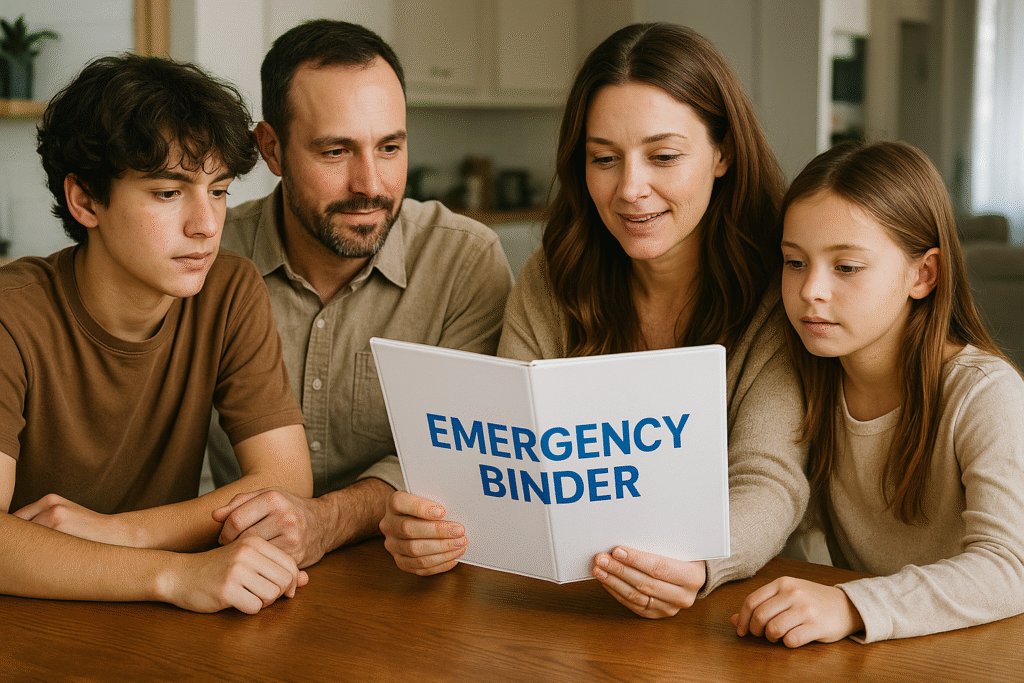
Here’s the thing about building a family emergency binder: it’s not really about the binder. It’s about the mindset.
You’re creating a system that says, “We don’t control everything, but we can control how ready we are.” That’s powerful. Especially for kids.
When you sit down with your family and work on this together (or at least explain what you’re doing and where it lives), you’re teaching them that preparation isn’t paranoia—it’s responsibility. You’re showing them that adulting includes boring stuff like knowing where documents are and having backup plans.
And weirdly, it’s also kind of reassuring. For you and for them.
The “Prepared, Not Panicked” Philosophy 🧘
We don’t talk about emergencies in our house like they’re inevitable doom. We talk about them like weather—sometimes it rains, and that’s why you keep an umbrella handy.
Building the binder wasn’t a fear-driven project. It was a “let’s make life easier when things get complicated” project. There’s a huge difference in how kids process those two approaches.
Research from Harvard’s School of Public Health has suggested that teaching preparedness calmly can help kids cope better in stressful situations. That tracks with what we’ve noticed in our own family—treating emergencies like solvable problems instead of catastrophes seems to help kids feel more in control. Makes sense when you think about it.
So yeah, involve your kids. Make it normal. Make it practical. And watch them grow into adults who don’t fall apart when life throws curveballs. (Building healthy family routines works the same way—small habits, big impact.)
Family Preparedness Skills by Age 📈
Watch how capabilities grow as your system matures:
SKILL DEVELOPMENT TIMELINE
Year 1: Foundation Building
├─ Parents know the system [████████████████████] 100%
├─ Teens can navigate basics [████████████░░░░░░░░] 60%
├─ Young kids know location [████████░░░░░░░░░░░░] 40%
└─ System is reliable [██████████░░░░░░░░░░] 50%
Year 2: Growing Confidence
├─ Parents are experts [████████████████████] 100%
├─ Teens use independently [████████████████░░░░] 80%
├─ Young kids understand purpose [██████████████░░░░░░] 70%
└─ System is trusted [██████████████████░░] 90%
Year 3: Full Integration
├─ Parents maintain effortlessly [████████████████████] 100%
├─ Teens can teach siblings [███████████████████░] 95%
├─ Young kids can find basics [██████████████████░░] 90%
└─ System is second nature [████████████████████] 100%
The first year is setup. Years 2-3 are where magic happens. 🌟
Patience pays off. This becomes family culture, not just a binder on a shelf.
Wrapping It All Up: Just Start Simple 🎯
Look, I know this feels like a lot. Sections and schedules and updates and backup plans. But here’s the secret: you don’t have to build the perfect family emergency binder in one weekend.
Start with five documents: 1️⃣ Emergency contact list
2️⃣ Insurance cards (front and back)
3️⃣ Copy of driver’s license
4️⃣ Medical info for anyone with allergies or chronic conditions
5️⃣ Utility company phone numbers
Stick those in a binder. Boom—you’re ahead of 90% of families.
Then add to it when you think about it. Updating your car registration? Toss a copy in the binder. At the pediatrician and they give you an updated immunization record? Snap a photo and print it later. Build it slowly. Build it imperfectly.
Because the goal isn’t perfection. The goal is better than nothing.
Think of your emergency binder as adulting’s ultimate cheat sheet. It’s the instruction manual you write for yourself (and your family) so that when chaos inevitably shows up, you’ve got a starting point. Not a solution to everything—but a place to begin.
Final Thought: Peace of mind doesn’t come from avoiding emergencies. It comes from being prepared when they happen. 🌟
So grab a binder. Print five pages. Stick them in sheet protectors. Put it somewhere obvious. Congratulations—you’ve just leveled up your household preparedness game.
And next time someone asks you for your insurance card, your kid’s medical history, or the phone number for literally any utility company, you’ll know exactly where to look. You’ll feel like a wizard. And your family will thank you.
(Or at least they’ll stop asking you where everything is. Which is basically the same thing.)
Now go build that binder. You’ve got this. 💪
Your Simple Start Checklist 📋
Copy this, print it, and get going:
┌─────────────────────────────────────────────────────┐
│ WEEK ONE: THE ESSENTIALS │
├─────────────────────────────────────────────────────┤
│ ☐ Buy 2-3 inch binder + sheet protectors │
│ ☐ Create 5-7 section dividers with tabs │
│ ☐ Write emergency contact list (10 key numbers) │
│ ☐ Copy insurance cards (medical, auto, home) │
│ ☐ Scan driver's licenses for all adults │
│ ☐ List current medications for family │
│ ☐ Place binder in accessible location │
│ ☐ Tell family where it lives │
└─────────────────────────────────────────────────────┘
┌─────────────────────────────────────────────────────┐
│ WEEK TWO: BUILD ON SUCCESS │
├─────────────────────────────────────────────────────┤
│ ☐ Add allergy information for each person │
│ ☐ Include school/work emergency contacts │
│ ☐ List utility account numbers │
│ ☐ Add pediatrician/doctor contact info │
│ ☐ Create simple household map (breakers, shutoffs) │
│ ☐ Photograph important pages for digital backup │
└─────────────────────────────────────────────────────┘
┌─────────────────────────────────────────────────────┐
│ ONGOING: MAINTENANCE MODE │
├─────────────────────────────────────────────────────┤
│ ☐ Monthly glance-through (5 minutes) │
│ ☐ Quarterly updates (20 minutes) │
│ ☐ Annual overhaul (1 hour) │
│ ☐ Set phone reminders for each │
└─────────────────────────────────────────────────────┘
Done is better than perfect. Start today. ✨
More from Our Family of Blogs:
Lifetime Family Journey – Stories, guides, and lessons from life in a big family.
Mountains Will Move – Faith, resilience, and encouragement for life’s hardest battles.
Everyday Exposed – Real talk on culture, media, and the world we’re raising our kids in.
